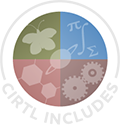Strategic Goal 1 (SG1) — Deepen the preparation of all future STEM faculty in evidence-based teaching, mentoring and advising practices that promote URG undergraduate success.
The SG1 Action Partnership is comprised of national future faculty programs, organizations with expertise and experience in STEM URG undergraduate success, and a member of the research team. The Action Partnership is also drawing upon extensive experience at colleges and universities throughout the alliance to tap into the collective expertise. The SG1 Action Partnership is designed as a learning community around collective impact processes and data-driven improvement cycles. The members of the Action Partnership will integrate their collective knowledge over the course of this pilot project.
SG1 Action Partnership: AAAS, ASEE, EE, IBP, NRMN, WEPAN, CGS, CIRTL
The SG1 National Coalition provides the SG1 Action Partnership with the national perspective on institutional needs and on the design for national impact, in addition to strategic planning described below.
SG1 National Coalition: AAAS, AAU, APLU, APS, ASEE, CGS, PULSE, SIST
The specific objectives of SG1 are to:
- Mutually agree upon a framework for the needs and attributes of evidence-based teaching, mentoring and advising practices that support URG success, and synthesize such practices both from literature and evaluated programs.
- Prepare a strategic plan for applying the knowledge syntheses to professional development of future faculty in Phase III. Both CGS and CIRTL have extensive experience in creating effective professional development activities.
- Drawing from extensive prior evaluation work, define agreed-upon metrics and an evaluation plan to determine if such professional development yields future faculty learning and early-career practice of teaching, mentoring and advising that improves URG undergraduate success. In parallel the National Coalition will develop a strategic plan for both scaling the newly developed professional development to all STEM future faculty and for advocacy. We aspire to build and trial a subset of the new future faculty development activities. Trialing can be straightforwardly done at a subset of CIRTL or CGS universities, or at colleges of the SG2 regional collaboratives. The trial evaluation data will inform an improvement cycle to guide scalability of both the future faculty development activities and the evaluation framework.
Strategic Goal 1 Frameworks
The frameworks were created in order to provide a tool which can be utilized in the preparation of future STEM faculty in evidence-based teaching, mentoring, and advising practices. Undergraduate students seeking advanced degrees in STEM areas has been trending towards increasingly diverse populations, however retention of under-represented groups (URG) in STEM continues to be a greater challenge than enrollment (National Science Board, 2018). Thus, the frameworks were designed to collate evidence-based practices that have been demonstrated to support and reduce barriers to URG STEM undergraduate success.
We have chosen to create frameworks from literature-based best practices around three aspects of undergraduate STEM partnerships with faculty: pedagogy, research mentoring, and advising. Strong faculty-student interactions from research mentoring and faculty advising have been shown to increase persistence of URGs in STEM undergraduate programs (Tsui et al., 2007).
Guide to the Mentoring, Advising, and Pedagogy Frameworks (PDF)
Undergraduate Research Mentoring Framework | (PDF)
Faculty Advising Framework | (PDF)
Inclusive Pedagogy Framework | (PDF)
Tsui, L. (2007). Effective strategies to increase diversity in STEM fields: A review of the research literature. The Journal of Negro Education, 76(4), 555-581.
National Science Board. 2018. Science and Engineering Indicators 2018. NSB-2018-1. Alexandria, VA: National Science Foundation. Available at https://www.nsf.gov/statistics/indicators/.
